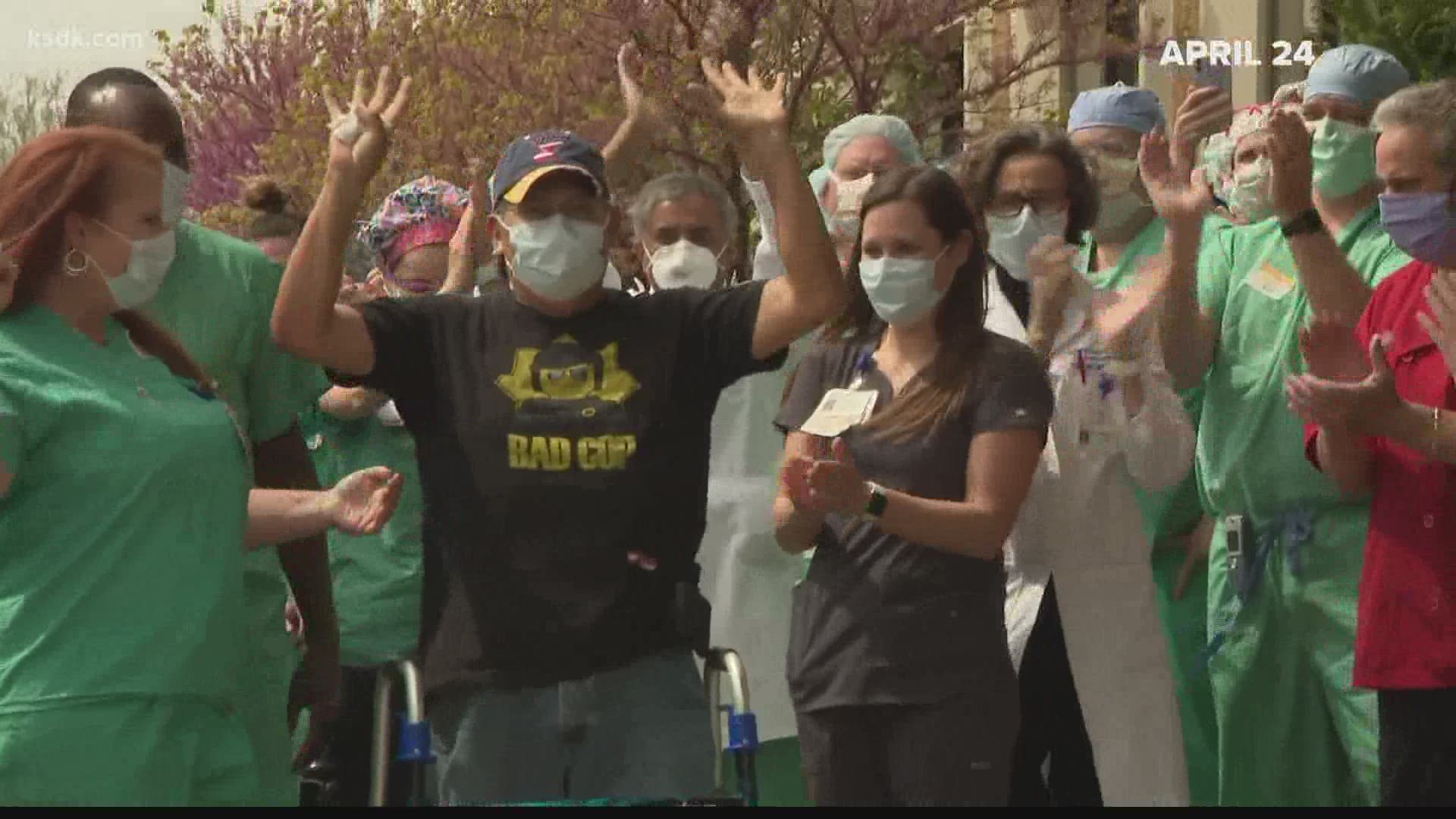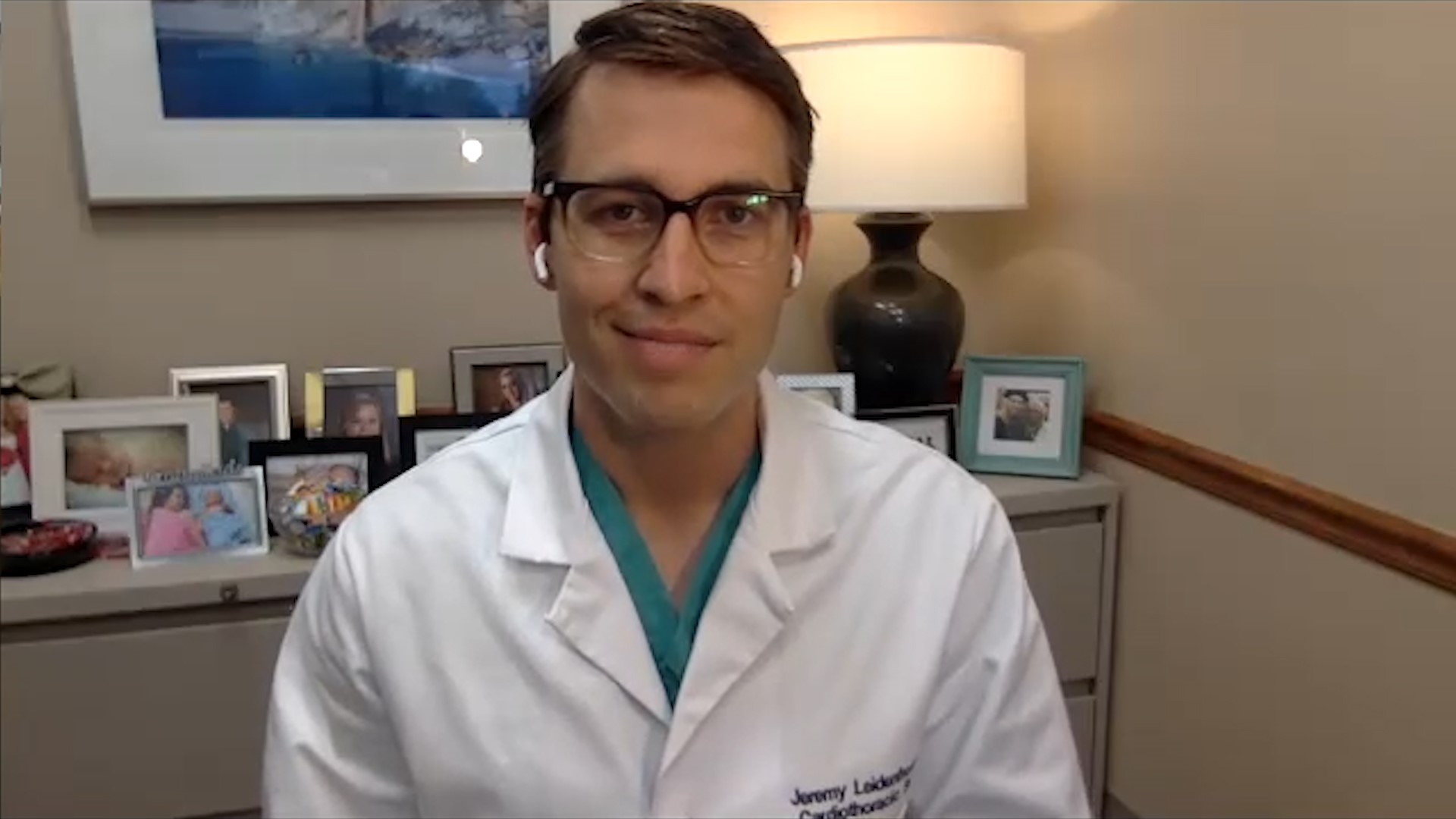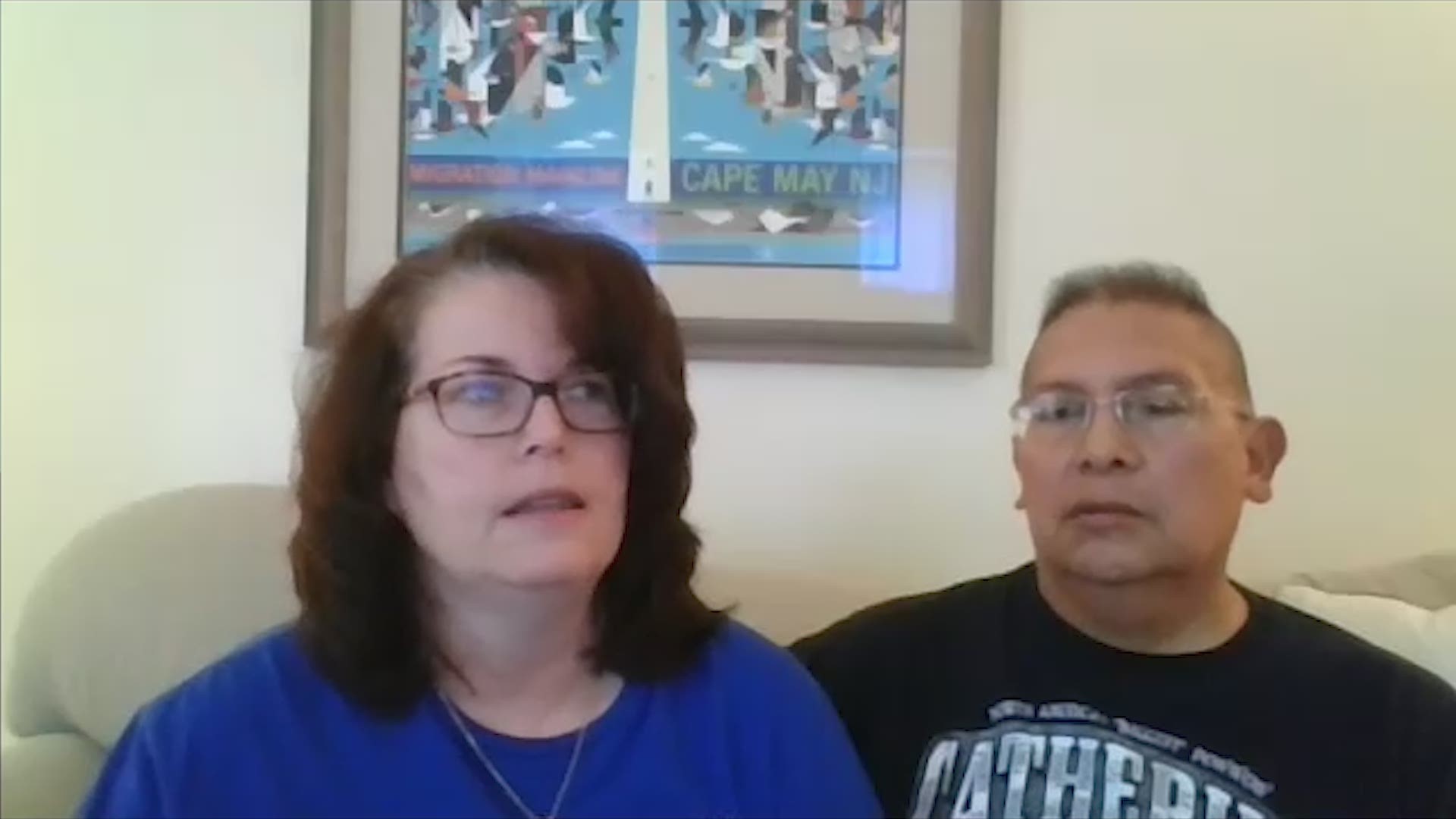ST. LOUIS — Whether he’s serving with the Air Force during Desert Storm; policing the streets of St. Louis; surviving motorcycle accidents and heart attacks, Dave Tenorio always comes home.
His recent battle with COVID-19 was the first time his wife, Kathy, worried that he may not make it back.
Four days after she watched him walk into the emergency room, a doctor told her: “Things aren't looking good.”
“I just sat there, like, ‘No, I've never heard anybody say to me, ‘It’s not looking good’ before where Dave's concerned,” she said. “Dave comes home every time there's a crisis. I pray and I worry, but he always comes home.”
The 55-year-old had just hours to live when St. Luke’s Dr. Jeremy Leidenfrost put him on a treatment that saved his life in April. The doctor calls his recovery “remarkable,” and has written about it for a medical journal.
This week, Dave and his wife, Kathy, shared their story of survival exclusively with 5 On Your Side.
“Every day for me is an absolutely beautiful day, especially when I was told by the doctor the day before I left, ‘I've never seen anybody so close to death as you were."
‘The worst cough’
It began March 21 with a dry cough Dave Tenorio couldn’t shake when he came home from his shift as a motorcycle cop for the St. Louis police department. By that time, news of the pandemic was everywhere, and his wife said she was suspicious that he had the virus right away.
“It was the worst cough I’ve ever seen anybody have,” she said.
But, he didn’t have a fever, or any other symptoms – until about five days later when a low fever set in, as did body aches.
Kathy started coughing, too.
Still, the couple did not initially meet the criteria to be tested for the virus, so they said they self-quarantined at home.
Then, Tenorio’s captain called. One of his fellow traffic officers had tested positive for the virus.
Hillsboro had the nearest test site, so they drove there March 31 despite feeling sick.
“This virus is so strange,” Dave Tenorio said. “My symptoms would change every few days.
"Something else would come up. First, it was the cough. Then, body aches came on and then it was a loss of appetite and fatigue and it would be something different. And there was a period of time where I couldn't taste or smell and that subsided after several days and then my appetite was really bad for a while.”
But that next morning, on April 1, Dave woke up and told his wife he was short of breath and that his arm was feeling numb. Having survived two previous heart attacks, his wife drove him to St. Luke’s.
Then, it was time to say good-bye.
“We pulled up to the ER door. I got out and opened the door and he stood up and I hugged him and I said, ‘Everything's going to be OK,’” she said.
She gave him his cellphone, and told him to call her as soon as he knew something.
“That was it. I had no choice but to leave him, you know, just dump him off there at the ER door,” she said.


‘The phone went dark’
Dave Tenorio said he doesn’t remember much from the early days.
“I couldn't even begin to imagine the agony she was going through wondering what was going on because she literally just had to drop me off and I was on my own,” he said.
Kathy forgot her cellphone in her rush to get out the door. A text from her husband was waiting for her when she got home.
“Good thing we came, I’m having a heart attack,” he wrote.
Dave told his wife that doctors were placing a stent.
“We were just talking like, ‘We dodged another bullet,’ because that's kind of how we both felt,” Kathy Tenorio said.
But the relief didn’t last long.
Dave called her back a few hours later. His oxygen levels were dangerously low. Doctors were putting him on a ventilator.
Later, a nurse told him: “I could have started crying because your lungs were just completely white, which meant there was no oxygen in them whatsoever and they knew then that it was looking really bad for me.”
He tested positive for the coronavirus.
“That really was the last thing I expected to hear,” Kathy Tenorio said.
Her husband told her: “I'm not worried. It's going to be OK. I'm coming home to you.”
“But then my phone went dark as far as Dave was concerned,” she said. “I just sat frozen on the couch thinking, ‘What just happened?’
“It just was not on my radar that morning when I took him.”


‘Save his life’
Five days after Kathy dropped her husband off at the emergency room, Dr. Jeremy Leidenfrost, a cardiothoracic surgeon at St. Luke’s Hospital called.
“He told me, ‘The ventilator is not helping him anymore,’” she said.
Again, she froze.
Then, he told her there was one last treatment he wanted to try called ECMO, which is short for Extracorporeal membrane oxygenation.
She grabbed the nearest piece of mail she could find to take notes as he explained how the process drains the blood from the biggest vein in a person’s body and sends it through tubes into machines that oxygenate it before sending it back into the right atrium of the heart.
The machines essentially act as artificial lungs outside a person’s body.
The tubes were the size of water hoses, Dave Tenorio said.
The treatment is reserved only for the most severe patients, typically facing cardiac or other respiratory illnesses, Leidenfrost said.
But, it’s had some success for COVID-19 patients.
Some.
He listened to podcasts from Italian doctors who treated COVID patients with ECMO.
“Before the pandemic, we knew that patients were being placed on ECMO in Italy with varying rates of success and myself and the ECMO directors of both Barnes Jewish Hospital and Missouri Baptist got together and decided on criteria, basically, who we would treat and who we would not treat and what modalities we were going to use to treat these patients,” he said. “We knew it was coming and that we needed to prepare for it."
Italian doctors said patients with kidney failure had mortality rates as high as 100% with ECMO.
“We learned from their experience and built on it," Leidenfrost said. "And I think it was very valuable information to have because I think we understand more about who is salvageable when their lungs totally fail with this viral pneumonia.”
Leidenfrost said he believes the stress of Tenorio’s diminished lung capacity triggered his heart attack, but it wasn’t enough of a factor to dissuade him from recommending the treatment.
“Dave was in his 50s. He was previously healthy. He was a motorcycle police officer. And a very robust individual,” he said. “ECMO is very, very hard on somebody's body and it requires a healthy person to start off with to get through it. So he was he was a very good candidate for it, and it was a basically a last resort for him.
“Without being placed on ECMO I don't think he would have lasted the rest of the day.”
Kathy said she won’t forget Leidenfrost’s words.
“He said, ‘It’s risky, but I think that’s what we need to do,’” Kathy Tenorio recalled. “And I said, ‘By all means necessary doctor, save his life, whatever you need to do.’”
‘God is working through your hands’
The procedure to connect Dave Tenorio to the machines went well.
Leidenfrost warned Kathy Tenorio that it could take weeks before her husband improved. The first few days passed with no signs of improvement – but no signs of worsening, either.
“I just told him, ‘I believe in you. I believe in the hospital and I believe God is working through your hands,’” she recalled.
The process demands highly-skilled nursing and almost constant monitoring, Leidenfrost said.
“We use this technology and it is an amazing technology, but if you don’t have the people to actually take care of someone, minute-to-minute, it doesn’t mean anything," he said. "People don’t survive.
"You can’t just put someone on ECMO and say, ‘Oh, it’s going to be fine now.’ You have to have somebody who is willing to watch them and understand this incredibly complicated device and then also be able to recognize when there are problems with it and know when to call. They took it very seriously and really took it to heart and owned it. That’s the only reason this guy survived.”
The doctor grew emotional recalling how he watched the nurses carry out his orders to keep Dave alive.
“When you're sedated and you've got huge tubes that are this big coming out of your body and you can't move, you obviously don't understand what's going on to you,” he said, using his hand to show the quarter-sized diameter of the tubes connected to Dave’s body.
They attached pictures of their smiling faces to their scrubs so Dave and other COVID patients could see who was caring for them.
“It really put the human back into the medicine because it’s so incredibly dehumanizing to have to cover yourself up and take care of somebody and it can also be terrifying to know you’re taking care of someone with this potentially fatal disease that you could get, too,” he said. “It chokes you up.”

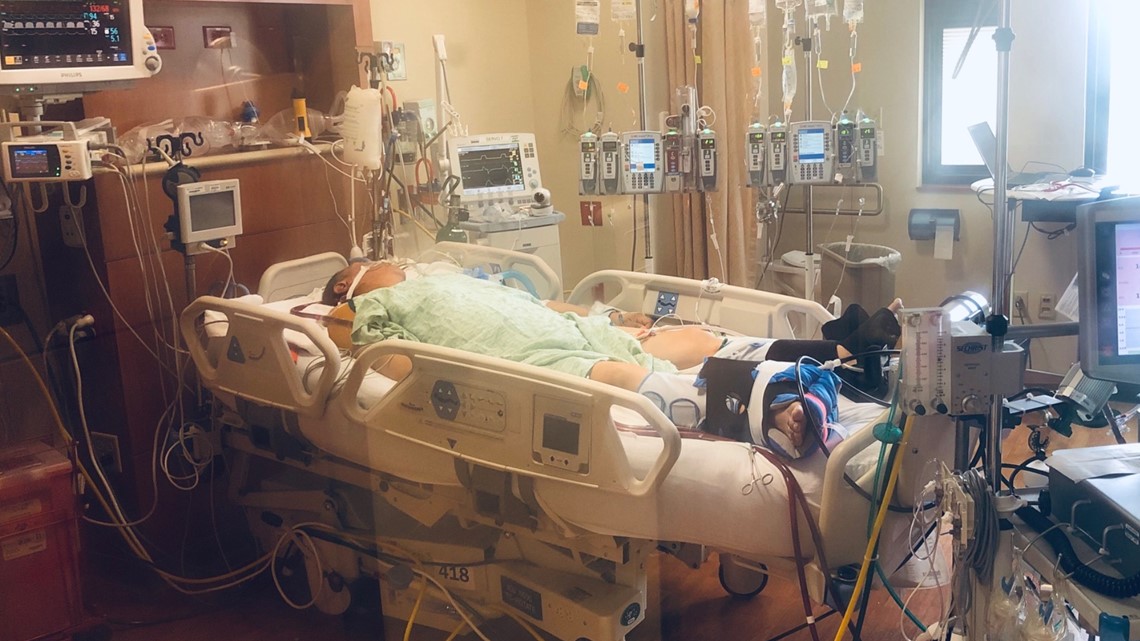
‘Being born again’
On Easter Sunday, Leidenfrost called Kathy again.
This time, he said things were “looking better.”
“I told everybody, ‘You know what happened, this is an Easter miracle, we've witnessed a miracle today,” she recalled. “And once he started to improve, it was like a snowball running.”
After one week on ECMO, doctors put Dave Tenorio back on a ventilator. Days later, he was breathing on his own again.
Then, the physical recovery began.
“It was like being born again as a 55-year-old,” he said. “I had to be taught everything all over again because my mind was there. But my body just wasn't listening to my brain and they said it was going to be a little while before I could get that back.”
He could barely walk 6 feet from his bed without feeling exhausted and winded.
“It was extremely difficult and it was frustrating for me because I've never been so weak,” he said. “I've never been so dependent on anybody for anything like that before.
“I just kept telling myself, ‘You're going to make it. There are just so many people out there, pulling for you, praying for you and a lot of it was from people I didn't even know. They knew me just from doing what I do.”

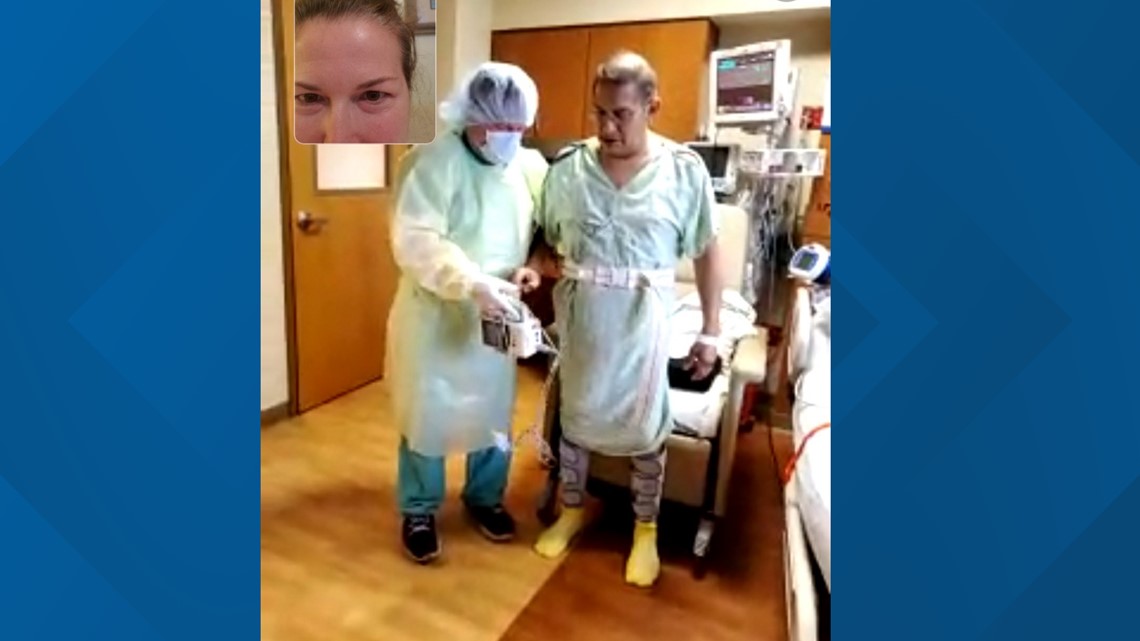
For 23 of his 26 years on the police force, Tenorio has ridden a motorcycle for the department.
He’s been a fixture at almost every downtown event, directing traffic for Blues games, Cardinal games, concerts, etc. The military buzz cut he’s worn since his days in the Air Force is usually tucked under his black and white helmet. His dark sunglasses rest on his high cheekbones, protecting his almond-shaped eyes – common features among his Pueblo Indian tribe.
Even Leidenfrost said he recognized him from his tours of duty, keeping traffic moving and watching over crowds.
By April 24, he was ready to go home. He said he could barely hold the pen to sign his discharge papers.
“I think a first grader could probably sign their name better than I did that day,” he quipped.
Dozens of hospital personnel lined the sidewalk. Chief John Hayden and Public Safety Director Jimmie Edwards were among the crowd.
“I felt like I was planning a wedding,” Kathy Tenorio quipped of organizing the moment.
Dave and his wife embraced.
He weighed 40 pounds less than the last time she hugged him just three weeks before that moment.
“It was a very surreal feeling that afternoon,” he said. “Everybody made me feel like I was a rock star.
“The cheering and the clapping and everything that was just so incredibly loud. It was like being at a concert. It was incredible.”
A police escort ensured he made it home.


Back home
Now, three weeks into his recovery at home, he says he continues to regain his strength.
At first, he couldn’t climb the 14 stairs to his second-floor bedroom, and he couldn’t stand without his wife’s help.
“I was probably a jerk sometimes and I apologized to her for that, but it was just very frustrating for me, even though I knew I was recovering well, it was very frustrating for me because I've never been in a situation where I had been so dependent on somebody, but it was an incredible thing how well she took care of me and didn't say a word.
“Maybe she rolled her eyes once in a while because I was being a dope, but if she did, I wouldn't blame her.”
The two-pound weights he came home using are now five pounds.
His lung scan on Monday was clear, he said.
He’s continuing with physical therapy and cardiology check-ups.
He and his wife wear masks in public even though they’ve both tested negative for the virus.
“I would never preach to anybody,” he said. “The only thing I could say is if you don't think this is real, you can come talk to me.”
The couple is also planning to donate their plasma to help doctors research the virus, and answer why some people are affected by the virus so differently than others.
Dave Tenorio thinks it could be months before he’s back on his police motorcycle again.
He walks twice a day in his neighborhood with his wife to build up his strength.
The walks started out as just feet at a time. Then, blocks. This week he got to a mile.
He’s looking forward to walking on his own.
And to coming home to his wife, like he always does.

